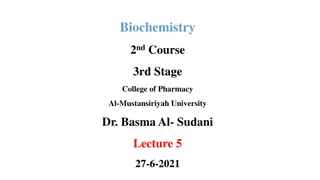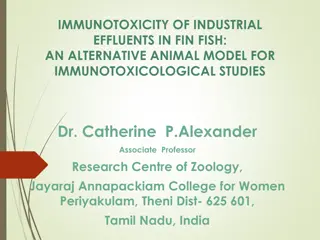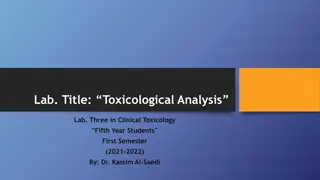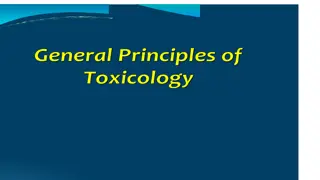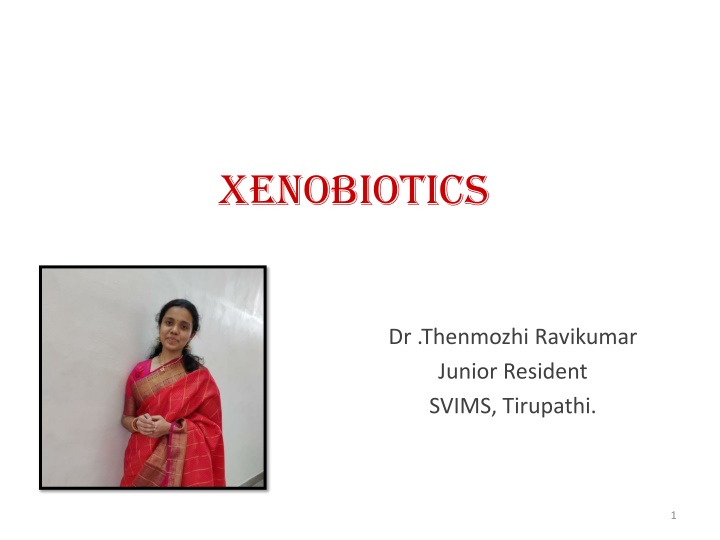
Xenobiotics and Their Metabolism
Explore the metabolism of xenobiotics, foreign compounds in the body, their effects, and biotransformation reactions. Gain insights into the mechanisms involved and the potential applications in rendering pollutants harmless.
Download Presentation

Please find below an Image/Link to download the presentation.
The content on the website is provided AS IS for your information and personal use only. It may not be sold, licensed, or shared on other websites without obtaining consent from the author. If you encounter any issues during the download, it is possible that the publisher has removed the file from their server.
You are allowed to download the files provided on this website for personal or commercial use, subject to the condition that they are used lawfully. All files are the property of their respective owners.
The content on the website is provided AS IS for your information and personal use only. It may not be sold, licensed, or shared on other websites without obtaining consent from the author.
E N D
Presentation Transcript
Xenobiotics Dr .Thenmozhi Ravikumar Junior Resident SVIMS, Tirupathi. 1
Contents : 1. Introduction 2. Metabolism of Xenobiotics 3. Phase I reaction 4. Phase II reaction 5. Cytochrome P450 6. Toxic effects to xenobiotics 7. Summary 2
Xenobiotics In Greek, Xenos = Stranger / foreign Definition : A xenobiotics is a compound that is foreign to the body, that are not normally produced by humans. Xenobiotics can produce a variety of biological effects including 1. Pharmacological responses 2. Toxicity 3. Immunologicol responses 4. Carcinogenic effects 3
Knowledge of the metabolism of xenobiotics is essential for an understanding of pharmacology, therapeutics, and toxicology. Types of xenobiotics : Exogenous Endogenous Drugs Bilirubin Food additives Bile acids Pollutants Steroids Insecticides Carcinogens 5
Understanding the mechanisms involved in xenobiotic metabolism will permit the development of transgenic microorganisms and plants. Can be used to render potentially hazardous pollutants harmless. 6
CHARACTERISTICS : Penetrate membrane by diffusion Transported by lipoproteins in blood Require chemical conversion to facilitate excretion Lipophilic 7
Biotransformation Reactions: A process by which a substance is changed to another chemical by a chemical reaction within the body. Consequences : Changes in solubility characteristics Detoxification Metabolic activation 8
These reactions maybe : Desirable: as in the activation of a prodrug to the active compound. Undesirable: as in the formation of a carcinogen or mutagen from an inert precursor. 9
Potentially toxic xenobiotics Detoxification Inactive metabolite Prodrug Metabolic activation Reactive metabolite 10
Detoxification reaction: Biochemical reaction involved in the conversion of foreign toxic and water insoluble molecules to nontoxic, water soluble and excretable form. Purpose : Converts lipophilic to hydrophilic compounds facilates excretion 11
Role of liver : Major organ involved Heptaocytes contain wide variety of enzymes to process xenobiotics Enzymes are present in endoplasmic reticulum and to lesser extent in other organelles Each enzyme represents a large family of gene product Each gene product maybe induced by different xenobiotics . 12
Metabolism of Xenobiotics Two phases of metabolism: Phase I Phase II Alteration of xenobiotics molecule so as to add a functional group which can be conjugated in phase2 Compounds produced in phase1 are converted by specific enxymes to various polar metabolites by conjugation. They become more water soluble and excretable form Oxidation, reduction , hydrolysis, deamination, dehalogenation, desulfuration, epoxidation,peroxygenation Glucuronic acid, sulfate, acetate, glutathione, certain amino acids, by methylation. 13
Phase I reaction: Oxidation Reduction Hydrolysis They are also called hydroxylation reactions , since they introduce or expose a functional group (eg: -OH) that serves as active centres for sequential conjugation in a phase II reaction. 14
Phase II: Conjugation Phase 2 reaction prepare xenobiotics for excretion It involves covalent attachment of small polar endogenous molecule such as glucuronic acid , sulfate or glycine to form water soluble compounds. Conjugation reactions can occur independently or can follow phase I ( hydroxylation) reactions. 15
Conjugation takes primarily in liver but can occur in kidney also. By the end of conjugation , the products are rendered non- toxic Glucuronidation is the most frequent conjugation reaction. With the exception of glutathione conjugation, most conjugation reactions involving xenobiotics are secondary, involving, as substrates, the products of phase I reactions. 16
At least 8 different conjugating agents have been identified in the body. 1. Glucuronic acid, 2. Glycine, 3. Cysteine, 4. Glutamine, 5. Methyl group, 6. Sulfate, 7. Acetic acid and 8. Thiosulfate. 17
Phase I phase II Oxidation Conjugation Reduction conjugated drugs are And/ or hydrolysis usually inactive 19
Following phase1 , the drug/carcinogen maybe activated or unchanged or most often inactivated. Some drugs directly enter phase 2 metabolism. 20
1.Oxidation : Oxidation of alcohols : primary aliphatic and aromatic alcohols are oxidized to corresponding acids Eg: Methanol formaldehyde Ethanol acetaldehyde Acetic acid Formic acid 2.Reduction: Para nitro phenol 3.Hydrolysis : Aspirin + H2O para aminophenol Salicylic acid + acetic Acid 21
Phase I reaction enzymes: Mainly catalyzed by a class of enzymes referred to as monooxygenases, mixed function oxidases or cytochrome P450s. Other enzymes of significance are 1. Aldehyde and alcohol dehydrogenase 2. Deaminases 3. Estrases 4. Epoxide hydrolases 22
Properties of human cytochrome P450s: Involved in phase I of the metabolism of innumerable xenobiotics Involved in the metabolism of many endogenous compounds They catalyze reactions involving introduction of one atom of oxygen into the substrate and one into water 23
There are atleast 57 genes for Cyt P450 genes in human genome CYP system also known as mixed function oxidase system since as it involves both oxidation and reduction. CYP functions as the terminal oxidase in the electron transport chain. 24
Numbered so because..... Originally discovered when it was noted that preparations of microsomes that had been chemically reduced and then exposed to carbon monoxide had an absorption peak at 450 nm. 26
All are haemoproteins Exhibit broad substrate specificity, thus act on many compounds Extremely versatile catalyst, about 60 types of reactions 27
Liver contains highest amounts , but found in most if of all tissues including small intestine , brain and lung. Located in smooth endoplasmic retinaculum 28
Molecular weight 55kDa Many are inducible ,resulting drug interactions Many are inhibited by various drugs or their metabolic providing another cause of drug interactions. 29
Some exhibit genetic polymorphism which can result in atypical drug metabolism At least half of the common drugs that we ingest are metabolized by isoforms of cytochrome P450. 30
Nomenclature for the cytochromes P450 It is a systematic nomenclature Based on their amino acid sequence homology. Terminologies : Root, Family, Subfamily, Individual 31
Eg: CYP1A1, CYP2A6 The Root - CYP denotes a cytochrome P450. 1- designating the family; cytochromes P450 are included in the same family if they exhibit >40% amino acid sequence identity. Capital letter A indicating the subfamily; P450s are in the same subfamily if they exhibit > 55% sequence identity. 1- individual of the subfamily 32
The major cytochromes P450 involved in drug metabolism are CYP1 (with 3 subfamilies), CYP2 (13 subfamilies), and CYP3 (1 subfamily). The various cytochromes P450 have overlapping substrate specificities, so that a very broad range of xenobiotics can be metabolized by one or other of the enzymes. 33
Induction of cytochrome P450 underlies drug interactions, when the effects of one drug are altered by administration of another. For example: warfarin is metabolized by CYP2C9, which is induced by phenobarbital Induction of CYP2C9 will increase the metabolism of warfarin, so reducing its efficacy, so that the dose must be increased. 34
The P-450 system catalyzes reactions that either detoxify xenobiotics or, less commonly, convert xenobiotics into active compounds that cause cellular injury. 35
CYP2E1 catabolizes the metabolism of some widely used solvents and compounds found in tobacco smoke, many of which are pro-carcinogens; it is induced by ethanol, so increasing the risk of carcinogenicity. It is also called as MEOS- microsomal ethanol oxidizing system 36
Naturally occurring compounds in foods may also affect cytochrome P450. Grapefruit contains a variety of furanocoumarins, which inhibit cytochrome P450 It affect the metabolism of many drugs 38
Aflotoxin B1 to 8,9- epoxide is an example of making an active metabolite by CYP450. 39
Polymorphism of cytochromes P450 may explain much of the variation in xenobiotic responses by different patients 41
FLAVIN CONTAINIMG MONOOXYGENASES FMOs are microsomal enzymes, monooxygenases requiring NADPH and oxygen, and existing as multiple isoforms in various tissues. FMO is found in highest levels in the liver but is also found in significant levels in the lung and kidney 42
Unlike CYPs, catalyze only oxygenation reactions, have more specific substrate requirements, and are not known to be subject to induction or inhibition by xenobiotics, apart from competitive inhibition by alternate substrates. The mechanism of catalysis is also distinct in that electrons are transferred directly from NADPH, and not via an NADPH reductase. 43
There are five types of FMOs were reported. In humans, there is a switch around birth from the predominately fetal FMO1 to the predominately adult FMO3. FM03 is important in the metabolism of several pharmaceuticals and xenobiotics including the chemotherapeutic drugs. 44
ELIMINATION Just as wastes from normal metabolic processes are excreted in the urine, feces, and exhaled air, xenobiotics and their metabolites are also excreted from the kidneys, liver, and lungs. Chemicals that are rapidly eliminated may have limited phase I metabolism 45
Why do we bother about Xenobiotics ?? 47
Toxic effects of xenobiotics Undesirable effects covers a wide spectrum, but can be considered under three general headings: 1. Cytotoxicity 2. Altering antigenicity 3. Chemical carcinogenisis 48
1. Cytotoxicity: Covalent binding of xenobiotic metabolites to macromolecules including DNA, RNA, and protein can lead to cell injury Occurs by severely impaired ATP formation, and cell death 49
2. Altering antigenicity: The reactive metabolite of a xenobiotic may bind to a protein, acting as an hapten, and altering its antigenicity Resultant antibodies react not only with the modified protein but also with the unmodified protein, potentially initiating autoimmune disease. 50

